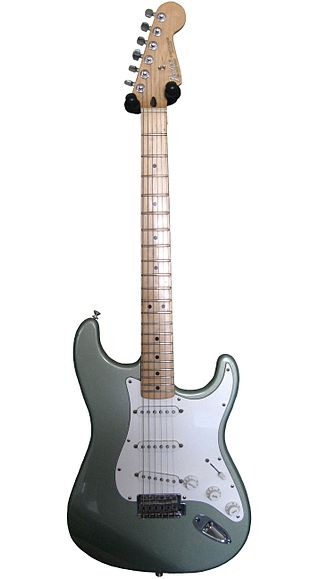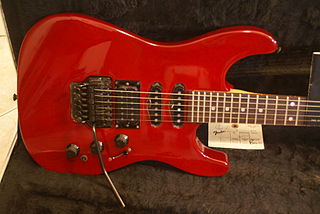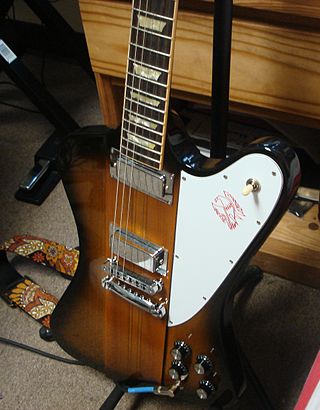
The guitar is a fretted musical instrument that typically has six strings. It is usually held flat against the player's body and played by strumming or plucking the strings with the dominant hand, while simultaneously pressing selected strings against frets with the fingers of the opposite hand. A plectrum or individual finger picks may also be used to strike the strings. The sound of the guitar is projected either acoustically, by means of a resonant chamber on the instrument, or amplified by an electronic pickup and an amplifier.
Rickenbacker International Corporation is a string instrument manufacturer based in Santa Ana, California. The company is credited as the first known maker of electric guitars – a steel guitar in 1932 – and today produces a range of electric guitars and basses.

The Fender Stratocaster, colloquially known as the Strat, is a model of electric guitar designed between 1952 and 1954 by Leo Fender, Bill Carson, George Fullerton, and Freddie Tavares. The Fender Musical Instruments Corporation has continuously manufactured the Stratocaster since 1954. It is a double-cutaway guitar, with an extended top "horn" shape for balance. Along with the Gibson Les Paul, Gibson SG, and Fender Telecaster, it is one of the most-often emulated electric guitar shapes. "Stratocaster" and "Strat" are trademark terms belonging to Fender. Guitars that duplicate the Stratocaster by other manufacturers are sometimes called S-Type or ST-type guitars.

The Fender Showmaster is a discontinued model of electric guitar made by Fender, and is characteristic of a superstrat. Also see the badge change of Stagemaster due to legal reasons.
The Fender Jaguar is an electric guitar by Fender Musical Instruments characterized by an offset-waist body, a relatively unusual switching system with two separate circuits for lead and rhythm, and a short-scale 24" neck. Owing some roots to the Jazzmaster, it was introduced in 1962 as Fender's feature-laden top-of-the-line model, designed to lure players from Gibson. During its initial 13-year production run, the Jaguar did not sell as well as the less expensive Stratocaster and Telecaster, and achieved its most noticeable popularity in the surf music scene. After the Jaguar was taken out of production in 1975, vintage Jaguars became popular first with American punk rock players, and then more so during the alternative rock, shoegazing and indie rock movements of the 1980s and 1990s. Fender began making a version in Japan in the mid-1980s, and then introduced a USA-made reissue in 1999. Since then, Fender has made a variety of Jaguars in America, Mexico, Indonesia and China under both the Fender and Squier labels. Original vintage Jaguars sell for many times their original price.

Music Man is an American guitar and bass guitar manufacturer. Originally formed in 1971 by Forrest White and Tom Walker, along with Leo Fender as a silent partner, the company started manufacturing electric and bass guitars under the Music Man name in 1974. In 1984 it was acquired by Ernie Ball, the subsidiary of which is branded as Ernie Ball Music Man.

Superstrat is a name for an electric guitar design that resembles a Fender Stratocaster but with differences that clearly distinguish it from a standard Stratocaster, usually to cater to a different playing style. Differences typically include more pointed, aggressive-looking body and neck shapes with increased cutaways to facilitate access to the higher frets, an increased number of frets on the fingerboard, a contoured heel at the neck joint facilitating easier higher fret access, the usage of humbucking pickups, and locking vibrato systems, most commonly the Floyd Rose.

The Gibson Firebird is a solid-body electric guitar manufactured by Gibson beginning in 1963.

B.C. Rich is an American brand of acoustic and electric guitars and bass guitars founded by Bernardo Chavez Rico in 1969.

The Gibson Explorer is a type of electric guitar model by Gibson guitars, released in 1958. The Explorer offered a radical, "futuristic" body design, much like its siblings: the Flying V, which was released the same year, and the Moderne, which was designed in 1957 but not released until 1982. The Explorer was the final development of a prototype design that, years later, Gibson marketed under the name Futura.

Charvel is a brand of electric guitars founded in the 1970s by Wayne Charvel in Azusa, California and originally headquartered in Glendora, California. Since 2002, Charvel has been under the ownership of Fender Musical Instruments Corporation.
The Fender Toronado was an electric guitar made by Fender Musical Instruments Corporation. Introduced at the NAMM Show in 1998, it is a part of the "Deluxe Series" of Fenders produced in Mexico, generally to higher specs than most "Standard" models.
The Fender Lead Series was produced by the Fender/Rogers/Rhodes Division of CBS Musical Instruments. The series comprised Lead I, Lead II, Lead III and Lead Bass models.
The Jackson Soloist is an electric guitar model introduced by Jackson Guitars in 1984, although prototypes were available before then. The design is a typical "superstrat"; it varies from a typical Stratocaster because of its neck-thru design; tremolo: Floyd Rose or similar, Kahler; or a fixed Tune-O-Matic; premium woods; a deeper cutaway at the lower horn for better access to the higher frets, and a sharper body with squared-off edges.

The Fender HM Strat was an electric guitar produced by Fender Musical Instruments from 1988 until 1992. A relatively radical departure from Leo Fender's classic Stratocaster design, it was Fender's answer to Superstrats produced by manufacturers such as Jackson Guitars and Ibanez. The HM in the guitars name stands for heavy metal.
The Fender Bullet was an electric guitar originally designed by John Page and manufactured and marketed by the Fender Musical Instruments Corporation. It was first introduced as a line of "student" guitars to replace the outgoing Mustang and Musicmaster models.
Electric guitar design is a type of industrial design where the looks and efficiency of the shape as well as the acoustical aspects of the guitar are important factors. In the past many guitars have been designed with various odd shapes as well as very practical and convenient solutions to improve the usability of the object.

Kalamazoo is the name for two different lines of instruments produced by Gibson. In both cases Kalamazoo was a budget brand. The first consisted of such instruments as archtop, flat top and lap steel guitars, banjos, and mandolins made between 1933 and 1942, and the second, from 1965 to 1970, had solid-body electric and bass guitars.

TYM Guitars is a manufacturer of custom guitars and bass guitar based in Brisbane, Australia, as well as custom instruments the company also repairs, restores, refinishes vintage instruments. The line of custom guitars and basses built by TYM Guitars are influenced by manufacturers such as Mosrite, Rickenbacker, Epiphone, Danelectro, Fender and other models from the 1950s and 1960s, with several replicas and hybrids between different models being built to fit customer demand. TYM Guitars also has a retail shop that sells new and secondhand instruments and accessories from their own line of products and other manufacturers.
The Fender Telecaster, colloquially known as the Tele, is an electric guitar produced by Fender. Together with its sister model the Esquire, it was the world's first mass-produced, commercially successful solid-body electric guitar. Its simple yet effective design and revolutionary sound broke ground and set trends in electric guitar manufacturing and popular music.












